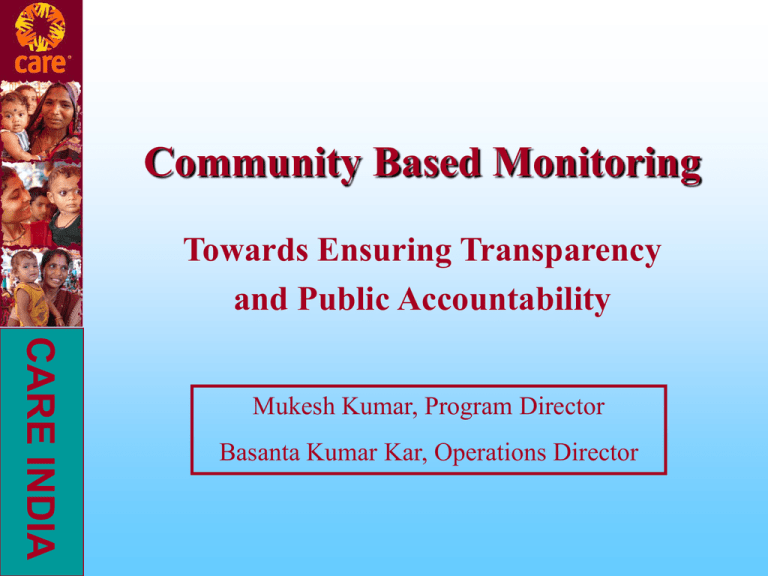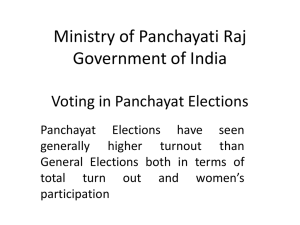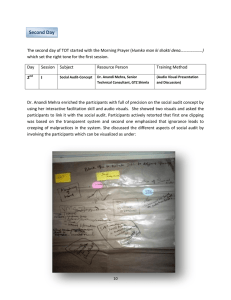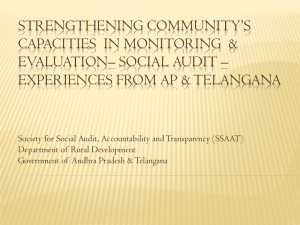Community Based Monitoring
advertisement

Community Based Monitoring Towards Ensuring Transparency and Public Accountability CARE INDIA Mukesh Kumar, Program Director Basanta Kumar Kar, Operations Director Structure of Presentation Model- I-IV Principles Scope and Elements CARE INDIA Change and Results Challenges Learning Models I: Nigrani Samiti (people based monitoring committee) II: Social Audit CARE INDIA III: Monitoring through Gram Sabha IV: Self monitoring tool (SMT) and social map Guiding Principles CARE INDIA • • • • • Participation and ownership Transparency and accountability Equity and diversity Rights and dignity Improving service delivery CARE INDIA Model I: Nigrani Samiti (People Based Monitoring Committee) Nigrani Samiti (People Based Monitoring Committee) CARE INDIA Scope and Element • A village level Committee with involvement of Panch/Sarpanch, SHG member and women with school teacher as president with adequate emphasis on representation of women from SC/ST population. • Meeting organized in each month. They look at distribution of supplementary Nutrition & health supplies at AWC and in some cases visit the households. • If problem is observed then it is referred to CDPO and Janpad Panchayat through Gram Panchayat. Existence in Madhya Pradesh and Chhattisgarh Results and Change CARE INDIA • Facilitates enrolment and coverage with emphasis on each hamlet. • Awareness building on entitlements- on services and supplies • Finding gaps on supplies and bringing to the notice of panchayat • Empowers poor women and promotes leadership at the local level institutions. Challenges CARE INDIA • Power relations: Dynamics of caste, class and gender relations inhibit greater involvement; • Legal bindings on recommendations: At times, actions on recommendations are not taken up seriously- diluting the accountability; • Capacity Building: Skill up gradation on functional literacy and limited capacities to monitor ends up the monitoring to be ritualistic. Model – II Social Audit CARE INDIA Scope and Element Social Audit is a democratic process of ensuring public accountability through a systematic demand and analysis of information by the community in the response to work/ program that have already been implemented . CARE INDIA Social Audit is not an audit of expenses or decisions alone but also an audit of how equitable have been the expenditures incurred or decision taken, the quality of work, and distributive justice. Piloted on Rajasthan, Chhattisgarh, Jharkhand, Bihar and Andhra Pradesh through ICDS Components, principles & processes of Social Audit Principles Components Process Integration with planning Multi perspective Equity Audit comprehensive • location of AWC Preparatory activities • Selection & identification of community •Social Audit committee in consultation with Gram Sabha • gender & caste segregated information •Environment building: Village level meeting, street play, photocopies of vouchers distributed Resources audit comparative CARE INDIA Conviction & coverage Equity • availability of the Govt.. schemes • material & physical resources Discourse Display Quality Audit • Supplementary nutrition , functioning of service providers • immunization,ANC • storage/ inventory • counseling, Home visit Discussion Feed Back & FollowUp Action Documentation & Sharing Result and Changes CARE INDIA • Builds peoples’ confidence & trust it ensures a good amount of female participation. • Provides a forum where people ask questions to PRI (Panchayati Raj Institutions), Govt. and Civil Society about their Role, Responsibility & Accountability • People from neighbouring villages attend Social Audits and demand that meeting be conducted in their villages to set right the discrepancies in other programs carried out by other agencies • It helps in modifying the program design & implementation • Works as novel method of monitoring & performance review without any cost • Prevents corruption and recovers lost Materials/Cash Challenges CARE INDIA • Organise Social Audit with govt. support from functionaries on a regular basis. • Access and analysis of inflow and expenditure of resources of NGOs/Govt. by the people or CBOs • Institutionalisation of Social Audit by CBOs and Government • Social Audit in intervals and follow ups • Absence of regular display of information and prior preparation (information of funds given to each individual as per the official records) inhibits community facilitation skill. • Display of charts sometimes can be a problem due to high illiteracy • Time consuming process (participation increases towards the end part of the discussion process. Many questions remain unsolved). CARE INDIA Model III: Self Monitoring Tool (SMT) and Social Map SMT and Social Map CARE INDIA Scope and Element: • Participatory process tools that enable individuals and communities to monitor their own behaviors and practices • User friendly processes • In-sync with local customs and traditions • Cost effective Piloted and replicated in the states of AP, Chhattisgarh, Madhya Pradesh, Jharkhand, West Bengal, Rajasthan, Uttar Pradesh & Orissa Change Agent on Social Map ANC during NHD Self Monitoring Tool Aspects of monitoring CARE INDIA • Enrollment and coverage • Early registration of pregnancies • Antenatal check-ups • TT shots, receipt and consumption of IFA • Availability of food stocks • Information related to deliveries, feeding behaviors • Vaccination of infants Self monitoring Result and Change CARE INDIA • Monitoring through SMT works as a process binding self and AWW for tracking changes and to discuss the emerging issues • Social map helps track inclusion, exclusion, leftout, drop-out, coordination between Change Agents/ASHA and AWW • Community takes charge of decline or increase of malnutrition in the village • Enhances community demand for services Challenges CARE INDIA • Institutionalization of the process by ICDS • Very much individual focused – at times lacks linkage with monitoring by service providers • Feed back to service providers & follow up action • Nutrition being a low priority for most of the poor reduces greater community involvement at village level • Motivation of AWWs and other service providers to replicate Model IV: People’s Monitoring through Gram Sabha CARE INDIA People’s Monitoring through Gram Sabha: Revitalize local governance for better health and nutrition Scope and Element • Gram Sabha integrates agenda on N&H with executive order and political mandate. During Gram Sabha people, elected representatives, service providers discuss and decide on health and nutrition agenda. Happens four times in a year and in some case special Gram Sabha on Nutrition and Health organized. CARE INDIA Result and Changes • Members ask question on home contacts and nutrition and health supplies • Allocate resources for infrastructure - AWCs, weighing scale, ANC table, BP instruments • Empower most marginalized women • Enables people know their entitlements; and • Enhances transparency Already in process in UP, Rajasthan, Chhattisgarh, MP, West Bengal, AP, Orissa People’s Monitoring through Gram Sabha: Revitalize local governance for better health and nutrition CARE INDIA Challenges • Power dynamics: class, caste & gender • Panch/Sarpanch Pati - Husbands speak on behalf the wife elected to local bodies • lack of quorum • In the absence of a pre-Gram Sabha, environment building for some Gram Sabha meetings end up to be a ritual Lessons for Future CARE INDIA • Making to be part of project lifecycle: Each model has its own strength and can be used in various stages of project • Each Model complements with one another • Legitimacy: Needs to be mandated through public policy and learnings can be built into program implementation on an ongoing basis. • Building Accountability: Appropriate actions on services and supplies gaps can build people’s confidence on the process • People’s capacity on functional literacy and facilitation of social audit and Gram Sabha is a pre –condition for success • Support from local bodies strengthens the process Lessons for Future CARE INDIA • PRA (charts, pictures, maps) tools combined with written statements and reports are more effective due to high level of illiteracy • Sensitization and capacity building of service providers and community members through cross visits, home contacts, counseling during NHDs and training enhances effectiveness • Environment building: Preparatory process before social audit and Gram Sabha and social map enhances community ownership and participation • Social Map with combination of other tool of micro-level planning updated bi-annually with ratification by local bodies works more effectively Thanks CARE INDIA








